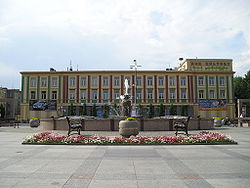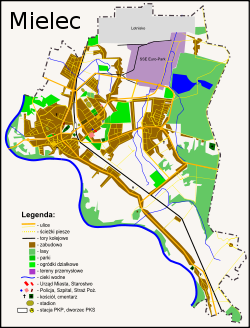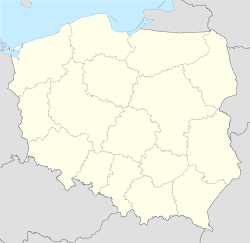- Mielec
-
Mielec Home Army Square 
Flag
Coat of armsCoordinates: 50°17′N 21°26′E / 50.283°N 21.433°E Country  Poland
PolandVoivodeship  Subcarpathian
SubcarpathianCounty  Mielec
MielecGmina Mielec (urban gmina) Established 1229 Town rights 1470 Government - Mayor Janusz Chodorowski Area - Total 47.36 km2 (18.3 sq mi) Population (2007) - Total 62,173 - Density 1,312.8/km2 (3,400.1/sq mi) Time zone CET (UTC+1) - Summer (DST) CEST (UTC+2) Postal code 39-300 to 39-303, 39-323 Area code(s) +48 17 Car plates RMI Website http://www.mielec.pl Mielec [ˈmjɛlɛt͡s] (Yiddish: מעליץ-Melitz) is a city in south-eastern Poland with a population of 60,979 inhabitants, as of June 2009.[1] It is located in the Subcarpathian Voivodeship (Województwo Podkarpackie) (since 1999); previously it was in Rzeszów Voivodeship (1975–1998). Mielec is the capital city of Mielec County.
Contents
History
The first mention of a place called Mielec appears in the thirteenth century in the 1229 bull of Pope Gregory IX. In the second half of the fourteenth century a parish Mielecka was mentioned in lists. Mielec city was founded on March 17, 1457, when King Casimir IV issued a permit to John Mielecki for the location of the city under the name of Nowy Targ. For unknown reasons he did not found the city; it was established by his two sons John and Bernard by the Act of 18 December 1470. The Mielecki family owned the town of Mielec until the last Mielecki heir died in 1771. Under their rule intensive development of handcrafts took place. In 1522 was found the oldest guild organization, the blacksmiths' guild, and subsequently guilds of tailors, cobblers, potters, spinners and weavers.
The next owners of Mielec were the Ossolinski and Morsztyn families. In 1775 Anna Ossilinska married John Pieniazek, bringing as dowry her inheritance of part of the city. The next owner was Ignatius Suchorzewski, who married Pieniazek’s daughter Paulina. Suchorzewski sold Mielec's goods to Louis Starzenski in 1847, who got rid of them ten years later to a Jewish family named Gross. The last owner of Mielec was the Oborski family in 1891.
In 1853 the county town of Mielec governed the area in which there were 106 settlements and 91 castral municipalities. In 1892 on Kosciuszko Street a new City Council building and police barracks were built. The development of the county town was interrupted by a huge fire, which destroyed three quarters of the city. This catastrophe caused the city to apply for a state loan of 12 crowns, the receipt of which led to the rapid development of the city. By the beginning of the twentieth century the market place in Mielec was surrounded by brick houses, and in 1902 a courthouse was built. In 1912 a gymnasium (academic high school) and the office of County Council were established and buildings constructed for them.
World War I caused much damage to the infrastructure and economy of Mielec town and county. In the interwar years many streets were paved with cobbles. In addition a private power plant, various craft workshops, and retail businesses were established. In 1934, the Mielec region suffered the biggest flood that destroyed more than 11,000 households.
Mielec's economy has been centered for the last 70 years around a single industrial enterprise, which transformed the city and increased its population sixfold. This process began in the 1930s, when Poland launched a significant expansion of its armaments industry, focused on building factories in the newly created Central Industrial Region (Polish: Centralny Okręg Przemysłowy, abbreviated COP). In 1936 a state-owned factory making airplane chassis was established (State Aviation Works - Airframe Fakcory No. 2) on the outskirts of the town, an area then known as Cyranka. The factory started to build a new bomber, the PZL P-37 or "Los" (English: "Moose"). In addition in the years 1937-1939 a large aviation factory of the PZL company was set up. The new manufacturing industry necessitated the development of residential housing for factory workers and management personnel.
After the outbreak of World War II, the city and the airplane company fell into the hands of the German invaders. In the years 1939-1944 the factory produced German bombers, and from 1943 also manufactured the fighter plane He–297. The Nazis staffed much of the factory with slave labor. Initially Jews from Mielec were enslaved there. In 1942 the Jewish population of Mielec was deported to death camps, except for a few who remained as slave labor at the factory. Before the war the Jewish population of Mielec was 2,800 out of a total population of 5,500. During the deportation the factory hangars were the site of a mass murder of several hundred of Mielec' Jews, who were buried there. Subsequently the factory used slave labor composed of Jews from other regions, prisoners of war, political prisoners, etc. After the war a monument was placed at the factory with a vague inscription typical of holocaust memorials during the Communist era: "To those employees of the Factory and the inhabitants from the area of both Polish and Jewish nationalities murdered during World War II: A tribute from Mielec's Youth." Another mass grave of Jews with a monument may be found in one corner of the Mielec Catholic cemetery, where the victims of a 1941 Nazi atrocity were buried. During the German occupation, all of Mielec' Jewish institutions and the Jewish cemetery were destroyed, and also many of the Jewish homes. After Poland’s liberation, the few surviving Mielezer Jews who returned found it impossible to rebuild their lives there due to hostility and threats of death from the Polish residents.
After 1945 into the factory became the largest aviation factory in Poland under the name WSK-Mielec "Wytwórnia Sprzętu Komunikacyjnego" (English: "Transport Equipment Manufacturing Centre"). This plant was the main source of employment for people in Mielec and surrounding communities. At first, the factory produced Soviet-designed planes under license. Thus, it was the primary production site of the widely used An-2 transport plane. It also manufactured Polish versions of the MiG-15 and MiG-17fighters. The factory also built planes designed in Poland such as the trainer plane TS-11 Iskra used by Poland and India. It produced over 16,000 aircraft, which were mainly licensed for export to the USSR.
After 1989 and the economic changes due to the fall of communism, factory orders declined and the plant encountered serious financial difficulties. It continued to produce successful aircraft types, but at much lower volumes than during the Cold War. Self-government of Mielec Township was established in 1990.
The situation changed in 1995, due to the establishment of Poland's first Special Economic Zone EURO-PARK Mielec. In 1998 the aviation plant changed its name to PZL-Mielec "Polskie Zakłady Lotnicze" (English: "Polish Aviation Works"). In 2007 the factory was acquired by Sikorsky, and was planned to be the main production site of the export version UH-60 Black Hawk helicopter.[2] Also, since 2005, Mielec has been the production site of sports-luxury car Leopard 6 Litre Roadster.[3][4] Golf carts are also manufactured in Mielec.
Historic Sites
- Minor basilica of Matthew the Evangelist, built in 1526
- Oborscys' manor-house from 17th century
- Jadernys' house (currently museum)
- Musical school
- St. Mark church
Economy
From the beginning of Centralny Okręg Przemysłowy Mielec is commonly associated with PZL Mielec aviation factory.
The first Special Economic Zone in Poland, SEZ EURO-PARK MIELEC, has been founded in Mielec in 1995[5] and has a positive impact on economy of Mielec.[5]
Sports
- FKS Stal Mielec - men's football team currently in 3rd league:
- Poland's Ekstraklasa Premier League: 1st place in 1972/73 season; 1st place in 1975/76 season; 2nd place in 1974/75 season; 3rd place in 1973/74 season; 3rd place in 1983/84 season.
- Polish Cup: finalist in 1976 season
- UEFA Cup: quarter-finalist in 1975/76 season
- European Champions Cup: first round elimination in 1973/74 season; first round elimination in 1976/77 season
- Notable players: Grzegorz Lato, Henryk Kasperczak, Andrzej Szarmach, Jan Domarski
- KPSK Stal Mielec - women's volleyball team playing in Liga Siatkówki Kobiet: 2nd place in 1999/2000 season
- SPR Stal Mielec – men's handball team playing in PGNiG Superliga
Education
Elementary schools
- Szkoła Podstawowa nr 1 im. Władysława Szafera w Mielcu
- Szkoła Podstawowa nr 2 im. Tadeusza Kościuszki w Mielcu
- Szkoła Podstawowa nr 3 im. Wojska Polskiego w Mielcu
- Szkoła Podstawowa nr 6 im. Żwirki i Wigury w Mielcu
- Szkoła Podstawowa nr 9 im. Władysława Jasińskiego "Jędrusia" w Mielcu
- Szkoła Podstawowa nr 11 im. Jana Pawła II w Mielcu
- Szkoła Podstawowa nr 12 im. Henryka Sienkiewicza w Mielcu
- Szkoła Podstawowa nr 13 im. Jana Bytnara "Rudego" w Mielcu
- Szkoła Podstawowa przy Niepublicznej Szkole Mistrzostwa Sportowego w Mielcu im. Grzegorza Lato
Gymnasiums
- Gimnazjum nr 1 w Mielcu
- Gimnazjum nr 2 w Mielcu
- Gimnazjum nr 3 w Mielcu
- Gimnazjum nr 4 w Mielcu
- Gimnazjum przy Niepublicznej Szkole Mistrzostwa Sportowego w Mielcu im. Grzegorza Lato
- Niepubliczne Gimnazjum prz Szkole Podstawowej nr 2
High Schools and Vo-Tech Schools
- I Liceum Ogólnokształcące im. Stanisława Konarskiego w Mielcu
- II Liceum Ogólnokształcące im. Mikołaja Kopernika w Mielcu
- Zespół Szkół Ogólnokształcących nr 1 w Mielcu im. st. sierż. pilota Stanisława Działowskiego
- V Liceum Ogólnokształcące
- Liceum przy Niepublicznej Szkole Mistrzostwa Sportowego w Mielcu im. Grzegorza Lato
- Zespół Szkół Budowlanych im. Żołnierzy Armii Krajowej w Mielcu
- Zasadnicza Szkoła Zawodowa Nr 2
- Technikum Nr 2
- II Liceum Profilowane
- Zespół Szkół Ekonomicznych w Mielcu
- Zasadnicza Szkoła Zawodowa Nr 1
- Technikum Nr 1
- I Liceum Profilowane
- Zespół Szkół Technicznych w Mielcu
- Zasadnicza Szkoła Zawodowa Nr 3
- Technikum Nr 3
- III Liceum Profilowane
- III Liceum Ogólnokształcące
- Szkoła Policealna Nr 3
- Technikum Uzupełniające Nr 3
- III Uzupełniające Liceum Ogólnokształcące
- Zespół Szkół im. prof. Janusza Groszkowskiego w Mielcu
- Zasadnicza Szkoła Zawodowa Nr 4
- Technikum Nr 4
- IV Liceum Profilowane
- IV Liceum Ogólnokształcące
Colleges and universities
- Wyższa Szkoła Gospodarki i Zarządzania
- Nauczycielskie Kolegium Języków Obcych (UMCS patronage)
- Grzegorz Lato - football player, senator, a president of PZPN
- Władysław Szafer - biologist
International relations
Twin Towns - Sister Cities
 Douchy-les-Mines in France (since 11 November 1990) [6]
Douchy-les-Mines in France (since 11 November 1990) [6] Mukacheve in Ukraine (since January 1993) [6]
Mukacheve in Ukraine (since January 1993) [6] Vila Nova de Poiares in Portugal (since June 2001) [6]
Vila Nova de Poiares in Portugal (since June 2001) [6]
References
- ^ "Population. Size and structure by territorial division". © 1995-2009 Central Statistical Office 00-925 Warsaw, Al. Niepodległości 208. 2009-06-02. http://www.stat.gov.pl/cps/rde/xbcr/gus/PUBL_P_population_size_structure_31_12_2008.pdf. Retrieved 2009-06-22.
- ^ "Newest BLACK HAWK Helicopter to Demonstrate Capabilities in First Visit to Poland". Prnewswire.co.uk. http://www.prnewswire.co.uk/cgi/news/release?id=205626. Retrieved 2008-10-31.
- ^ Leopard Automobile official website
- ^ History of Leopard Automobile
- ^ a b "Special Economic Zone EURO-PARK MIELEC". © 2009 Agencja Rozwoju Przemysłu S.A. Oddział w Mielcu ul. Partyzantów 25 39-300 Mielec. http://www.europark.com.pl/en/. Retrieved 2009-06-10.
- ^ a b c d e f "Mielec Official website - Partner Cities".
 (in Polish) © 1999-2008 Oficjalny serwis Urzędu Miejskiego w Mielcu. http://www.mielec.pl/miasta.php. Retrieved 2008-11-01.
(in Polish) © 1999-2008 Oficjalny serwis Urzędu Miejskiego w Mielcu. http://www.mielec.pl/miasta.php. Retrieved 2008-11-01.
External links
- Mielec home page (in Polish)
- PZL aviation factory in Mielec
- History of Mielec
- History of Jews of Mielec
Coordinates: 50°17′N 21°25′E / 50.283°N 21.417°E
Seat: Mielec (urban gmina) Urban-rural gminas 
Rural gminas Gmina Borowa • Gmina Czermin • Gmina Gawłuszowice • Gmina Mielec • Gmina Padew Narodowa • Gmina Tuszów Narodowy • Gmina Wadowice GórneSeat (not part of the gmina) Mielec
Villages Boża Wola • Chorzelów • Chrząstów • Goleszów • Książnice • Podleszany • Rydzów • Rzędzianowice • Szydłowiec • Trześń • Wola Chorzelowska • Wola Mielecka • ZłotnikiCategories:- Mielec
- Cities and towns in Podkarpackie Voivodeship
- Mielec County
Wikimedia Foundation. 2010.



